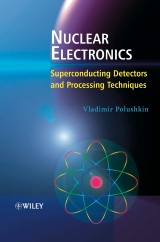Details

Nuclear Electronics
Superconducting Detectors and Processing Techniques1. Aufl.
|
136,99 € |
|
| Verlag: | Wiley |
| Format: | |
| Veröffentl.: | 19.11.2004 |
| ISBN/EAN: | 9780470857687 |
| Sprache: | englisch |
| Anzahl Seiten: | 402 |
DRM-geschütztes eBook, Sie benötigen z.B. Adobe Digital Editions und eine Adobe ID zum Lesen.
Beschreibungen
With the commercialisation of superconducting particles and radiation detectors set to occur in the very near future, nuclear analytical instrumentation is taking a big step forward. These new detectors have a high degree of accuracy, stability and speed and are suitable for high-density multiplex integration in nuclear research laboratories and astrophysics. Furthermore, superconducting detectors can also be successfully applied to food safety, airport security systems, medical examinations, doping tests & forensic investigations.<br /> This book is the first to address a new generation of analytical tools based on new superconductor detectors demonstrating outstanding performance unsurpassed by any other conventional devices. Presenting the latest research and development in nanometer technologies and biochemistry this book:<br /> * Discusses the development of nuclear sensing techniques.<br /> * Provides guidance on the design and use of the next generation of detectors.<br /> * Describes cryogenic detectors for nuclear measurements and spectrometry.<br /> * Covers primary detectors, front-end readout electronics and digital signal processing.<br /> * Presents applications in nanotechnology and modern biochemistry including DNA sequencing, proteinomics, microorganisms.<br /> * Features examples of two applications in X-ray electron probe nanoanalysis and time-of-flight mass spectrometry.<br /> This comprehensive treatment is the ideal reference for researchers, industrial engineers and graduate students involved in the development of high precision nuclear measurements, nuclear analytical instrumentation and advanced superconductor primary sensors. This book will also appeal to physicists, electrical and electronic engineers in the nuclear industry.
Preface. <p>1. Detection Methods with Cryogenic Particle and Radiation Sensors.</p> <p>1.1 Quasiparticle detectors. Interaction of nuclear radiation with superconductors.</p> <p>1.2 Superconducting tunnel junction (STJ) detectors.</p> <p>1.3 Microcalorimeters based on transition edge sensors (TES).</p> <p>1.4 Other cryogenic detectors.</p> <p>Chapter 2. Front-end Read-out Electronic Circuits.</p> <p>2.1 FET transconductance preamplifiers.</p> <p>2.2 Dynamics and noise of JFET amplifiers.</p> <p>2.3 SQUID current amplifiers.</p> <p>2.4 SQUID control electronics.</p> <p>2.5 SQUID amplifier in the small signal limit (noise).</p> <p>2.6 SQUID current amplifier in the large signal limit (dynamics).</p> <p>2.7 SQUID current amplifier at ultra low temperature.</p> <p>2.8 SQUID voltage amplifier.</p> <p>Chapter 3. Energy Resolution (FWHM) of Superconducting Detectors.</p> <p>3.1 Signal-to-noise ratio, equivalent noise charge and noise linewidth of nucleonic channels. General information.</p> <p>3.2 Signal-to-noise ratio, energy resolution at FWHM of STJ detectors.</p> <p>3.3 Noise equivalent power, energy resolution at FWHM of TES microcalorimeters.</p> <p>3.4 Dynamics and noise of time variant spectrometers.</p> <p>3.5 Signal-to-Noise ratio of detector arrays with multiplexed readout.</p> <p>Chapter 4. Pulse Processing Electronics.</p> <p>4.1 Pulse processing techniques.</p> <p>4.2 Analogue-to-digital conversion.</p> <p>4.3 Digital rise (fall) time discrimination.</p> <p>4.4 Superconductor digital spectrometer.</p> <p> 4.5 Selected topics on the hardware design.</p> <p>Chapter 5. Applications of Systems Based on Superconducting Detectors.</p> <p>5.1 Electron-Probe Nanoanalysis with cryogenic detectors.</p> <p>5.2 Biopolymer mass spectrometer.</p> <p>Chapter 6. Selected Topics of Analysis and Synthesis of Detector Systems.</p> <p>6.1 Analogue electronic circuitry analysis and design principles.</p> <p>6.2 Discrete-time systems and Systems with periodically changing parameters.</p> <p>6.3 Inductance calculations of the superconducting structures.</p> <p>Index.</p>
<b>Vladimir Polushkin</b> started his scientific career with the Joint Institute for Nuclear Research Russia in the Laboratory of Neutron Physics, headed by Nobel Prize winner I.M. Frank. After moving to Berlin (PTB) and later to Cambridge (Oxford Instruments Superconductivity), he is now a principal technologist for Oxford Instruments Analytical.
With the commercialisation of superconducting particles and radiation detectors set to occur in the very near future, nuclear analytical instrumentation is taking a big step forward. These new detectors have a high degree of accuracy, stability and speed and are suitable for high-density multiplex integration in nuclear research laboratories and astrophysics. Furthermore, superconducting detectors can also be successfully applied to food safety, airport security systems, medical examinations, doping tests & forensic investigations. <p>This book is the first to address a new generation of analytical tools based on new superconductor detectors demonstrating outstanding performance unsurpassed by any other conventional devices. Presenting the latest research and development in nanometer technologies and biochemistry this book:</p> <ul> <li>Discusses the development of nuclear sensing techniques.</li> <li>Provides guidance on the design and use of the next generation of detectors.</li> <li>Describes cryogenic detectors for nuclear measurements and spectrometry.</li> <li>Covers primary detectors, front-end readout electronics and digital signal processing.</li> <li>Presents applications in nanotechnology and modern biochemistry including DNA sequencing, proteinomics, microorganisms.</li> <li>Features examples of two applications in X-ray electron probe nanoanalysis and time-of-flight mass spectrometry.</li> </ul> <p>This comprehensive treatment is the ideal reference for researchers, industrial engineers and graduate students involved in the development of high precision nuclear measurements, nuclear analytical instrumentation and advanced superconductor primary sensors. This book will also appeal to physicists, electrical and electronic engineers in the nuclear industry.</p>


















